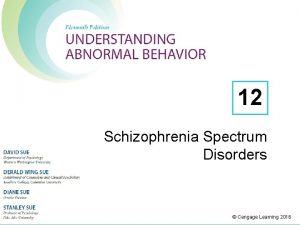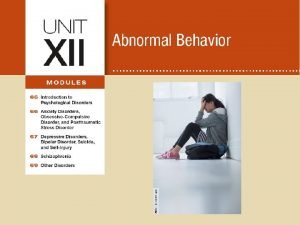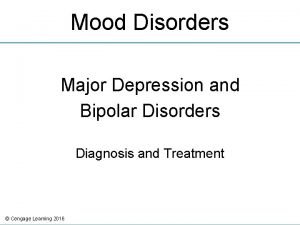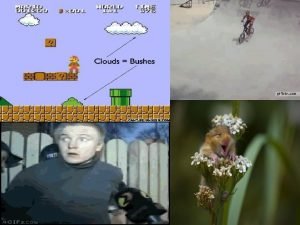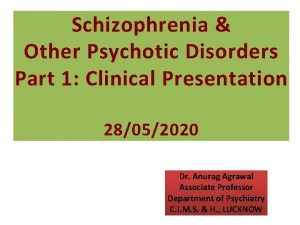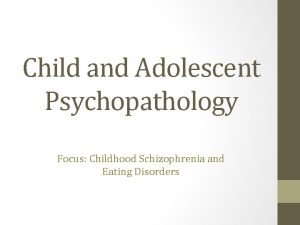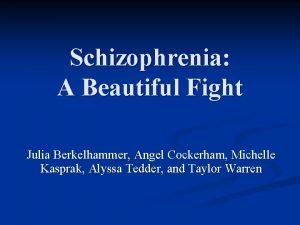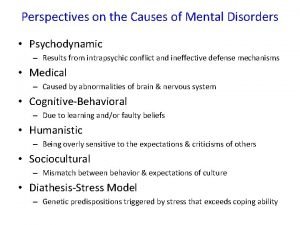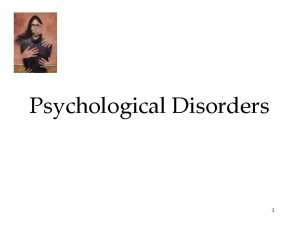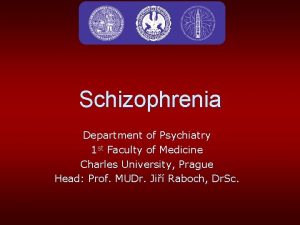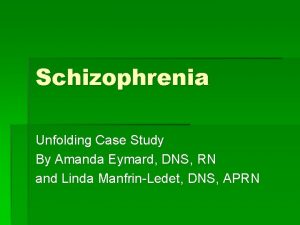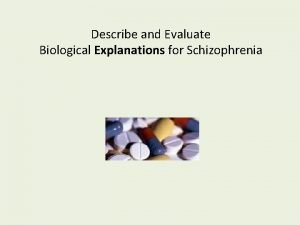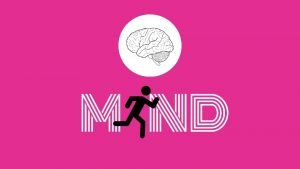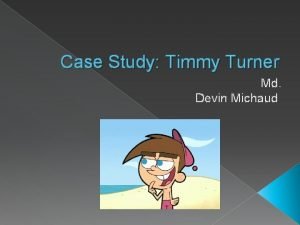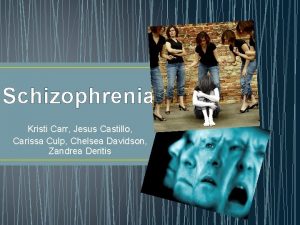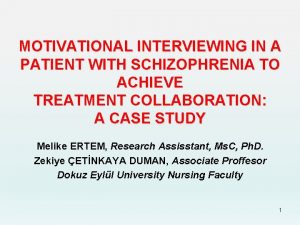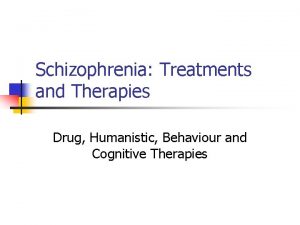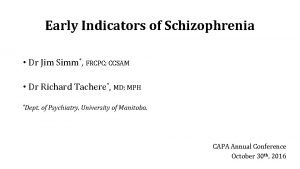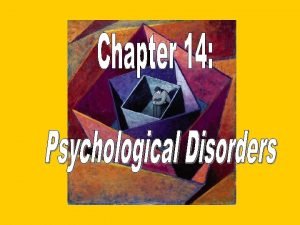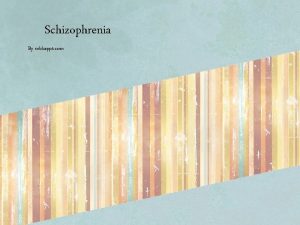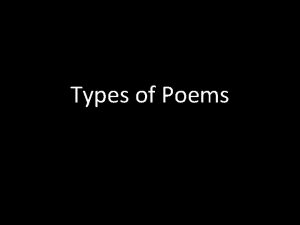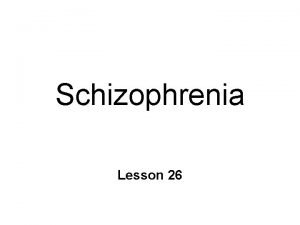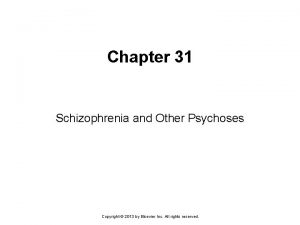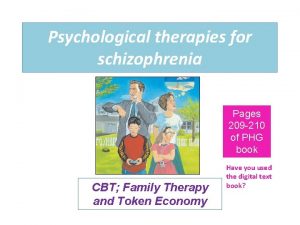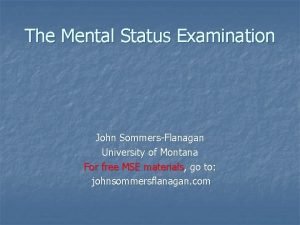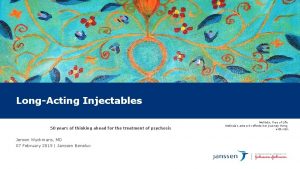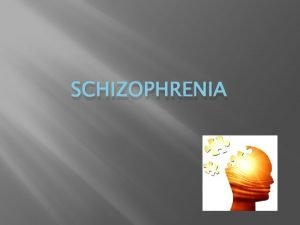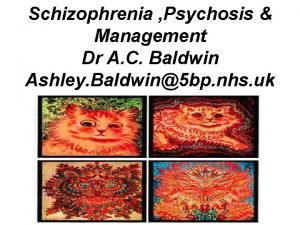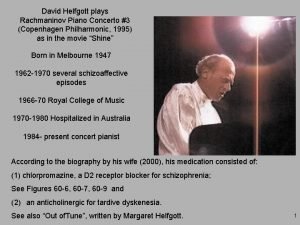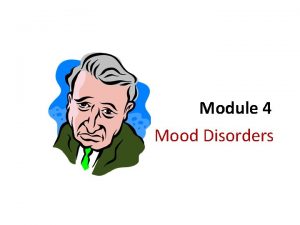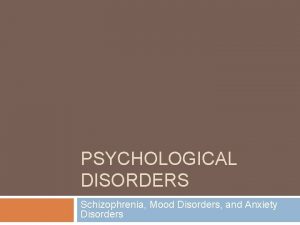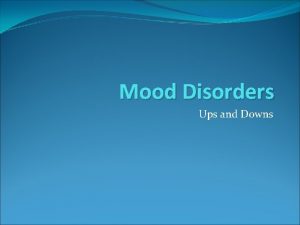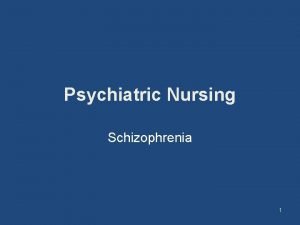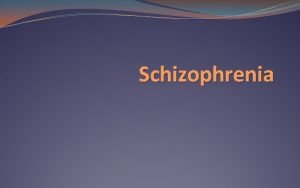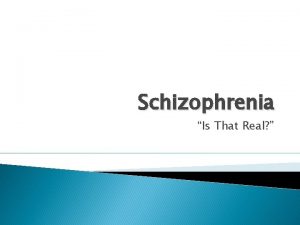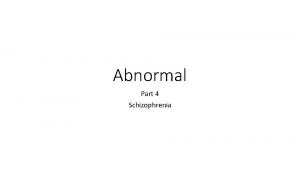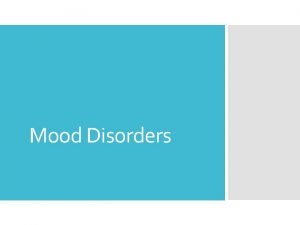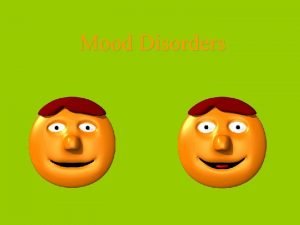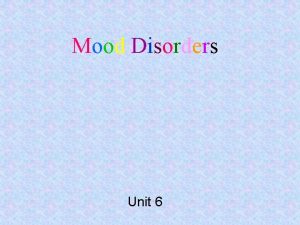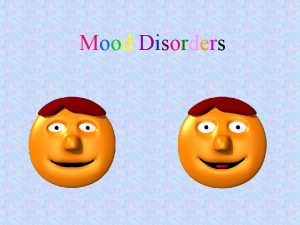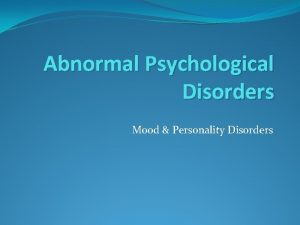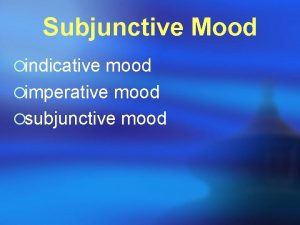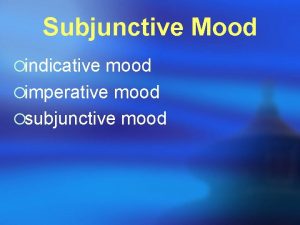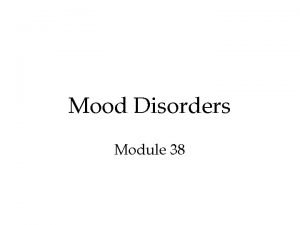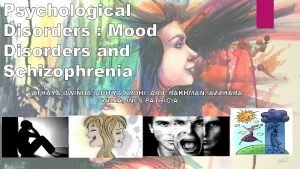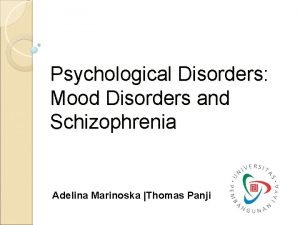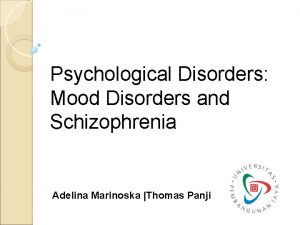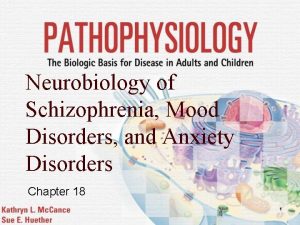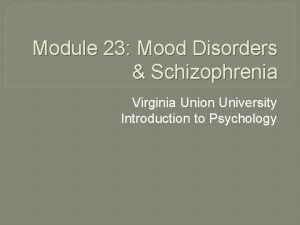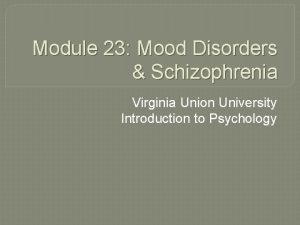Module 23 Mood Disorders Schizophrenia MOOD DISORDERS Mood

































- Slides: 33

Module 23 Mood Disorders & Schizophrenia

MOOD DISORDERS • Mood disorders – Prolonged, disturbed emotional state that affects almost all of a person’s thoughts, feelings, and behaviors • Major depression – Major depressive disorder – Marked by at least two weeks of continually being in a bad mood, having no interest in anything, and getting no pleasure from activities – Four of the following symptoms: problems eating, sleeping, thinking, concentrating, or making decisions; lacking energy; thinking about suicide; feeling worthless or guilty

MOOD DISORDERS (CONT’D) • Bipolar I disorder – Marked by fluctuations between episodes of depression and mania – Manic episode goes on for at least a week during which a person is unusually euphoric, cheerful, and high – Also has three of the following symptoms: great selfesteem, little need for sleep, rapid speech and frequently racing thoughts, easily distracted, and in constant pursuit pleasurable activities

MOOD DISORDERS (CONT’D) • Dysthymic disorder – Characterized by being chronically but not continually depressed for a period of two years – Person experiences at least two of the following: poor appetite, insomnia, fatigue, low self-esteem, poor concentration, feelings of hopelessness

MOOD DISORDERS (CONT’D) • Causes of mood disorders – Biological factors underlying depression • genetic, neurological, chemical, and physiological components that may predispose or put someone at risk for developing a mood disorder – Psychosocial factors • personality traits, cognitive styles, social supports, and the ability to deal with stressors interact with predisposing biological factors to put one at risk for developing mood disorders

MOOD DISORDERS (CONT’D)

MOOD DISORDERS (CONT’D) • Treatment of mood disorders – Major depression and dysthymic disorder • antidepressant drugs • increase levels of a specific group of neurotransmitters (monoamines-serotonin, norepinephrine, and dopamine) involved in the regulation of emotions and moods • SSRIs – selective serotonin reuptake inhibitors – Prozac, Zoloft • psychotherapy

MOOD DISORDERS (CONT’D) • Treatment of mood disorders – Bipolar I disorder • past drug of choice was lithium (mood stabilizer) • also included with lithium are antipsychotics and antidepressants – Mania • lithium has been found to be effective in treatment

ELECTROCONVULSIVE THERAPY • Definition and usage – Electroconvulsive therapy, or ECT • involves placing electrodes on the skull and administering a mild electric current that passes through the brain and causes a seizure • treatment consists of 10 to 12 sessions about three times per week • used when antidepressant medication fails to decrease depression • serious side effect of ECT is memory loss

ELECTROCONVULSIVE THERAPY (CONT’D)

ELECTROCONVULSIVE THERAPY (CONT’D) • Definition and usage – New treatment – Transcranial magnetic stimulation (TIMS) • noninvasive technique that activates neurons by sending pulses of magnetic energy into the brain

ELECTROCONVULSIVE THERAPY (CONT’D)

PERSONALITY DISORDERS • Definition – Inflexible, long-standing traits that significantly impair functioning or cause great distress in one’s personal and social life • DSM-IV-TR describes 10 personality disorders – Seven of the most common types • paranoid personality disorder – pattern of distrust and suspiciousness and perceiving others as having evil motives • schizotypical personality disorder – acute discomfort in close relationships, distortions in thinking, and eccentric behavior

PERSONALITY DISORDERS (CONT’D) – Seven common types • histrionic personality disorder – excessive emotionality and attention seeking • obsessive-compulsive personality disorder – intense interest in being orderly, achieving perfection, and having control • dependent personality disorder – pattern of being submissive and clingy because of an excessive need to be taken care of

PERSONALITY DISORDERS (CONT’D) – Seven common types • borderline personality disorder – pattern of instability in personal relationships, self-image, and emotions, as well as impulsive behavior • antisocial personality disorder – refers to a pattern of disregarding or violating the rights of others without feeling guilt or remorse

PERSONALITY DISORDERS (CONT’D) • Borderline personality disorder – Treatment • dialectical behavior therapy – type of cognitive-behavioral therapy – helps patient identify thoughts, beliefs, and assumptions that make their life challenging and teaches them different ways to think and react

SCHIZOPHRENIA • Definition and types – Schizophrenia • serious mental disorder that lasts for at least six months and includes at least two of the following symptoms: delusions, hallucinations, disorganized speech, disorganized behavior, and decreased emotional expression – symptoms interfere with personal or social functioning

SCHIZOPHRENIA (CONT’D) • Subcategories of schizophrenia – Paranoid schizophrenia • characterized by auditory hallucinations or delusions, such as thoughts of being persecuted by others or thoughts of grandeur – Disorganized schizophrenia • marked by bizarre ideas, often about one’s body (bones melting), confused speech, childish behavior, great emotional swings, and often extreme neglect of personal appearance and hygiene

SCHIZOPHRENIA (CONT’D) • Subcategories of schizophrenia – Catatonic schizophrenia • characterized by periods of wild excitement or periods of rigid, prolonged immobility • sometimes the person assumes the same frozen posture for hours on end

SCHIZOPHRENIA (CONT’D) • Chance of recovery – Type I schizophrenia • includes having positive symptoms, such as hallucinations and delusions • distortion of normal functioning • no intellectual impairment, good reaction to medication • good chance of recovery

SCHIZOPHRENIA (CONT’D) • Chance of recovery – Type II schizophrenia • includes having negative symptoms, such as dulled emotions and little inclination to speak, which are a loss of normal functions • has intellectual impairment • poor reaction to medication • poor chance for recovery

SCHIZOPHRENIA (CONT’D) • Symptoms – Disorder of thought, attention, and perception (hallucinations) – Motor disorders – Emotional (affective) disorders • Biological causes – Genetic predisposition – Genetic markers • identifiable gene(s) or a specific segment of a chromosome directly linked to some behavioral, physiological, or neurological trait or disease

SCHIZOPHRENIA (CONT’D)

SCHIZOPHRENIA (CONT’D) • Neurological causes – Ventricle size • 80% of brains of schizophrenics show larger than normal ventricles – Frontal lobe: prefrontal cortex • less activation of the prefrontal cortex • frontal and temporal lobes are smaller

SCHIZOPHRENIA (CONT’D)

SCHIZOPHRENIA (CONT’D) • Environmental causes – Incidences of stressful events and how individuals cope – Hostile parents, poor social relations, the death of a parent or loved one, and career or personal problems can contribute to the development and onset of schizophrenia – Diathesis stress theory • some people have a genetic predisposition (a diathesis) that interacts with life stressors to result in the onset and development of schizophrenia

SCHIZOPHRENIA (CONT’D) • Treatments – Positive symptoms of schizophrenia • reflect a distortion of normal functions: distorted thinking results in delusions; distorted perceptions result in hallucinations; distorted language results in disorganized speech – Negative symptoms of schizophrenia • reflect a decrease in, or loss of, normal functions: decreased range and intensity of emotions; decreased ability to express thoughts; and decreased initiative to engage in goal-directed behaviors

SCHIZOPHRENIA (CONT’D) • Treatments – Neuroleptic drugs (also called antipsychotic drugs) • used to treat serious mental disorders, such as schizophrenia, by changing the levels of neurotransmitters in the brain – Typical neuroleptics • primarily reduce levels of the neurotransmitter dopamine – Dopamine theory • dopamine neurotransmitter system is somehow overactive and gives rise to a wide range of symptoms

SCHIZOPHRENIA (CONT’D) • Treatments – Atypical neuroleptics • clozapine and risperidone lower levels of dopamine and also reduce levels of other neurotransmitters, especially serotonin • reduce positive symptoms, may improve negative symptoms, and reduce relapse

SCHIZOPHRENIA (CONT’D) • Evaluation of neuroleptic drugs – Typical neuroleptics • phenothiazines • can produce unwanted motor movements – Tardive dyskinesia • appearance of slow, involuntary, and uncontrollable rhythmic movements and rapid twitching of the mouth and lips, as well as unusual movements of the limbs

SCHIZOPHRENIA (CONT’D) • Evaluation of neuroleptic drugs – Atypical neuroleptics • risperidone, olanzapine • very low rate of tardive dyskinesia • can cause increased levels of glucose or blood sugar (hyperglycemia), excessive weight gain, and onset of, or worsening of, diabetes

DISSOCIATIVE DISORDER • Definition – Characterized by a person having a disruption, split, or breakdown in his or her normal integrated self, consciousness, memory, or sense of identity • Dissociative amnesia – Characterized by the inability to recall important personal information or events and is usually associated with stressful or traumatic events • Dissociative fugue – Disturbance marked by suddenly and unexpectedly traveling away from home or place of work and being unable to recall one’s past

DISSOCIATIVE DISORDER (CONT’D) • Dissociative identity disorder – Formerly called multiple personality disorder – Presence of two or more distinct identities or personality states, each with its own pattern of perceiving, thinking about, and relating to the world
 Chapter 12 schizophrenia spectrum disorders
Chapter 12 schizophrenia spectrum disorders Chapter 12 schizophrenia spectrum disorders
Chapter 12 schizophrenia spectrum disorders Module 68: schizophrenia
Module 68: schizophrenia Mood disorders
Mood disorders C device module module 1
C device module module 1 Schizophrenia literally means
Schizophrenia literally means Bleuler 4a
Bleuler 4a Example of loose associations in schizophrenia
Example of loose associations in schizophrenia Schizophrenia
Schizophrenia Loose associations
Loose associations Negative explanatory style
Negative explanatory style Hebephrenic schizophrenia
Hebephrenic schizophrenia Delusional thinking
Delusional thinking Biological explanations of schizophrenia
Biological explanations of schizophrenia What causes schizophrenia
What causes schizophrenia Timmy turner age
Timmy turner age Kristi carr
Kristi carr Motivational interviewing schizophrenia
Motivational interviewing schizophrenia Humanistic approach to schizophrenia
Humanistic approach to schizophrenia Jim simm
Jim simm I think i have schizophrenia
I think i have schizophrenia Thought insertion
Thought insertion Schizophrenia meaning
Schizophrenia meaning Types of poems
Types of poems Loose associations
Loose associations Types of schizophrenia
Types of schizophrenia Chapter 31 schizophrenia and other psychoses
Chapter 31 schizophrenia and other psychoses Two years ago jenny was diagnosed with schizophrenia
Two years ago jenny was diagnosed with schizophrenia Psychodynamic approach to schizophrenia evaluation
Psychodynamic approach to schizophrenia evaluation Mse sample report
Mse sample report Efficcity
Efficcity Sel tmu
Sel tmu Ashley baldwin
Ashley baldwin Genes schizophrenia
Genes schizophrenia
